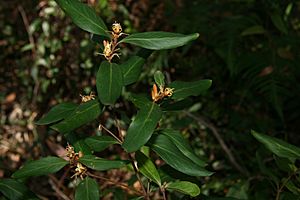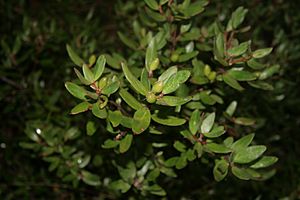Laurel geebung facts for kids
Quick facts for kids Laurel geebung |
|
|---|---|
 |
|
| Scientific classification | |
| Genus: |
Persoonia
|
| Species: |
laurina
|
| Synonyms | |
|
Persoonia ferruginea Sm. |
|
The Laurel Geebung (scientific name: Persoonia laurina) is a cool shrub found in central New South Wales, Australia. It's part of the Proteaceae plant family. This plant usually grows in sclerophyll forests and can reach up to 2 meters (about 6.5 feet) tall. Look out for its bright yellow flowers in late spring!
Contents
About the Laurel Geebung's Name
Plants get their scientific names from botanists, who are plant scientists. The Laurel Geebung was first described in 1805 by a scientist named Christiaan Hendrik Persoon. He named it Persoonia laurina.
The name laurina means it looks a bit like a laurel plant. Another botanist, James Edward Smith, also described this plant around the same time. He called it Persoonia ferruginea, which means "rusty" because of its rusty-brown hairs.
Later, scientists realized these were the same plant. Today, we use the name Persoonia laurina. It belongs to a group of three Persoonia species that all have a special woody part called a lignotuber.
Different Types of Laurel Geebung
There are actually three slightly different types, or subspecies, of the Laurel Geebung. Scientists officially recognized these subspecies in 1991. They are all very similar but have small differences in their features.
What the Laurel Geebung Looks Like

The Laurel Geebung grows as a shrub. It can be upright or spread out, reaching from 0.2 to 2 meters (about 8 inches to 6.5 feet) tall. Its new branches are covered in thick, grey to rusty-brown hairs.
This plant blooms with yellow flowers from November to January. When a Laurel Geebung seedling first sprouts, it has only two tiny leaves called cotyledons. This is different from many other plants in the Persoonia family, which often have more.
Life Cycle and Survival
All three types of Laurel Geebung have a special woody base called a lignotuber. This lignotuber helps the plant survive. If there's a bushfire, the parts above ground might burn away. But the lignotuber stays safe underground and can sprout new growth after the fire.
Some Laurel Geebung plants are thought to live for a very long time, possibly 50 to 100 years!
Uses and Growing Laurel Geebung
Aboriginal people traditionally used the bark of the Laurel Geebung. They would soak their fishing lines in it to make them stronger. They also ate the small fruits, called drupes, though they preferred the fruits from another plant called the Lance-leaf geebung.
The Laurel Geebung is a pretty plant that people might want to grow in their gardens. If you want to grow one, it needs soil that drains water well. It also likes a sunny spot or a place with some dappled shade. The soil should be a bit acidic.
This plant can handle frosts, which means it's quite tough. However, it doesn't seem to live very long when grown in gardens, sometimes only a few years. It's also a bit tricky to grow from seeds, but it's easier to grow new plants from cuttings taken from fresh growth.

